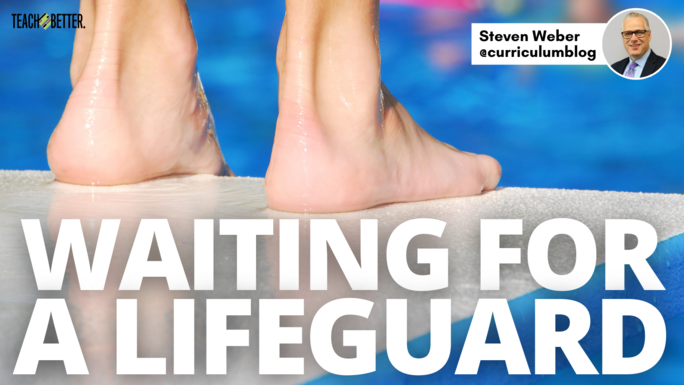TL;DR:
- Steven shares a story about how he and his dad were caught in a riptide and needed support from a lifeguard.
- Many students are struggling. We cannot expect them to save themselves. Hope is not a strategy.
- In order to focus on students’ needs, school support teams can ask themselves a list of questions found below.
- Consider how intentional you are in supporting struggling learners. One building principal kept a padfolio with a picture of these students so he can refer to them during classroom visits. Students are relying on school teams to support them.
In 1985, my dad and I were swimming in the Pacific Ocean. We were on a family vacation and we were enjoying family time in California. As we attempted to swim back to shore, we realized that the waves were pulling us deeper into the ocean and closer to the pier. Fortunately, a lifeguard saw what was happening and swam out to meet us. Later, he told us that a riptide—a strong current caused by tidal flow in confined areas such as inlets and presenting a hazard to swimmers and boaters—had forced us to go deeper into the water. My dad was a former college swimmer and diver, but the riptide was too strong. The lifeguard assisted us back to shore.
Students are depending on educators to have the hard dialogue. They don’t want to learn how to tread water, they want to swim! Click To TweetSchools are waiting for a lifeguard.
Hundreds of students in public, private, and charter schools are waiting for a lifeguard. Students are struggling to read, learn basic math skills, and recall what they learned the week before. Some students have been labeled with a disability or have struggled with school since kindergarten. Other students don’t have a disability, but they lose hope at some point as the education waters feel like they are pushing students deeper into the ocean. School districts analyze trend data and they know that achievement gaps exist.
However, some students continue to struggle and instructional strategies appear to remain the same. If my dad and I would have tried to save ourselves, we may have been pulled into the rocks near the pier. We cannot hope that students will save themselves. Hope is not a strategy.
Waiting for a Lifeguard: The following questions will support school teams as they focus on the needs of learners.
- What does the data say about teaching and learning in our school district?
- Which students are at-risk for struggling in this course or grade level, based on last year’s data?
- Who is the right fit for each student in need of a lifeguard? (i.e., teacher, counselor, mentor, social worker, advocate, and friend)
- How can we provide additional academic support and intervention?
- How can we provide additional behavior support and intervention?
- If the student’s family cannot afford academic tutoring and intervention, what can the school district do to provide additional support during the school day?
- Are we closing achievement gaps? If not, what do we need to do differently to support teaching and learning?
- How can we partner with community leaders and agencies to provide support to students and families?
- What barriers are preventing students from learning? (i.e., hunger, poverty, vision, dental, depression, loss of a loved one, or anxiety)
9b. How can the school staff or community agencies support students and help them overcome these barriers? - Does our school have common formative assessments that allow educators to monitor student understanding and growth in real time?
- Does our school district have a list of interventions, outlining the name of the intervention, frequency, names of students who are receiving the intervention, names of educators providing the intervention, and data on each student’s progress?
- Ask “Why?” questions. Example: Why do economically disadvantaged students continue to struggle with reading from grade 3 – 12?
In a former school district, I met with the building principal to discuss academic achievement, academic support, and how the school was supporting the students who were struggling the most.
The principal reached into his padfolio and pulled out a five page document. He had the yearbook pictures of the students who were one or more grade levels behind (by grade level and in alphabetical order). After he explained the “Academic Watch List” to me, we visited classrooms. He could show me the student’s picture before we walked into a classroom and then we could observe how the student was doing in class.
Is your school so intentional about supporting struggling students that the building principal has their picture and name in their padfolio? Placing a student’s name and face on a document often makes the work more transparent and personal than having an Excel spreadsheet from the state department of education with your school’s test scores.
[scroll down to keep reading]
Waiting for a Lifeguard: 3 Questions For School Teams
- Why not us?
- Why not now?
- What future opportunities do these students have if we don’t provide academic intervention and support?
“The courage to address tough topics comes from a deep commitment. No deep commitment, no hard dialogue.”
– Anthony Muhammad
Students are depending on educators to have the hard dialogue. They don’t want to learn how to tread water, they want to swim!
About Steven Weber
Dr. Steven Weber is the Associate Superintendent for Teaching and Learning with Fayetteville Public Schools (AR). His areas of research include curriculum design, formative assessment, professional learning, and school leadership.



